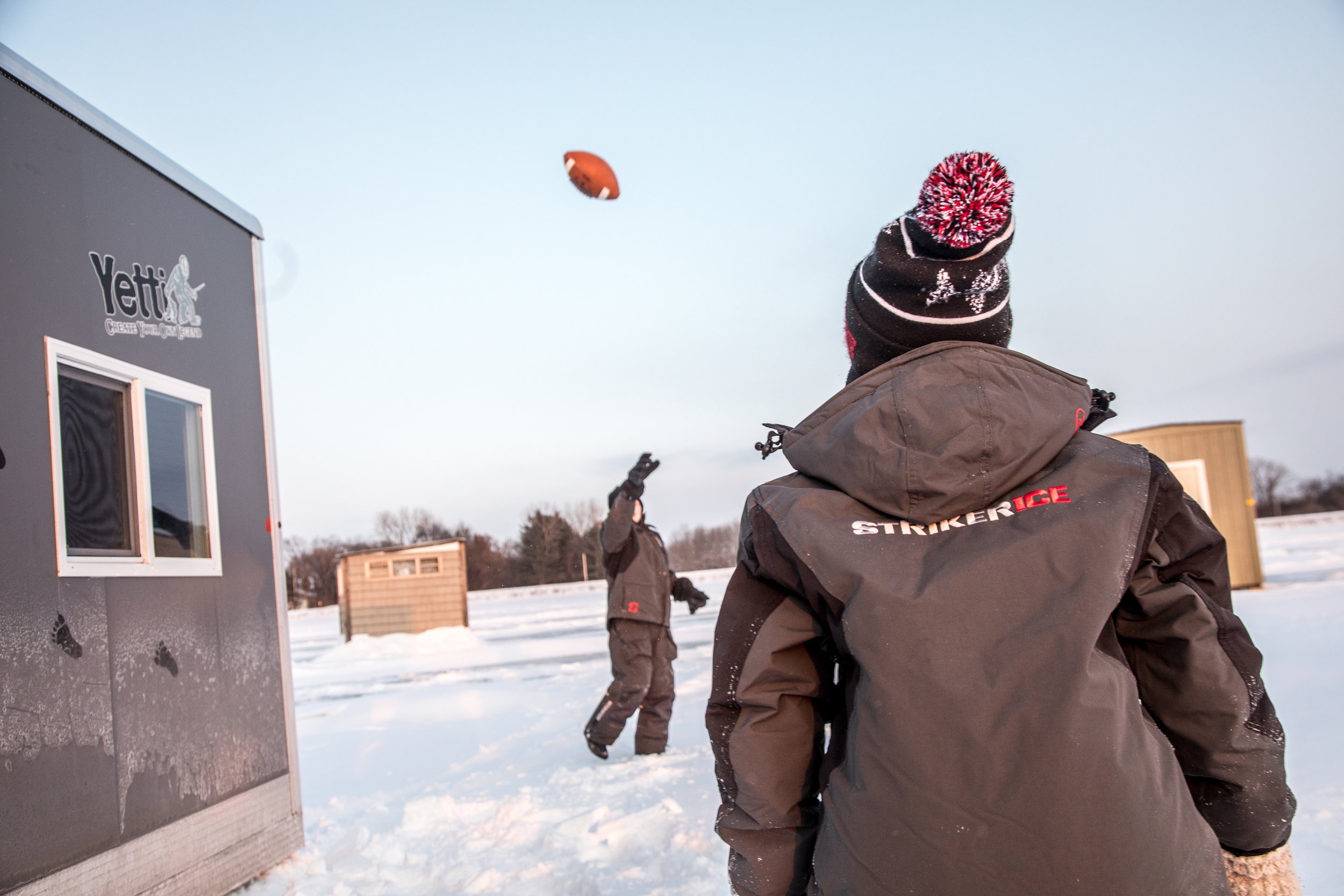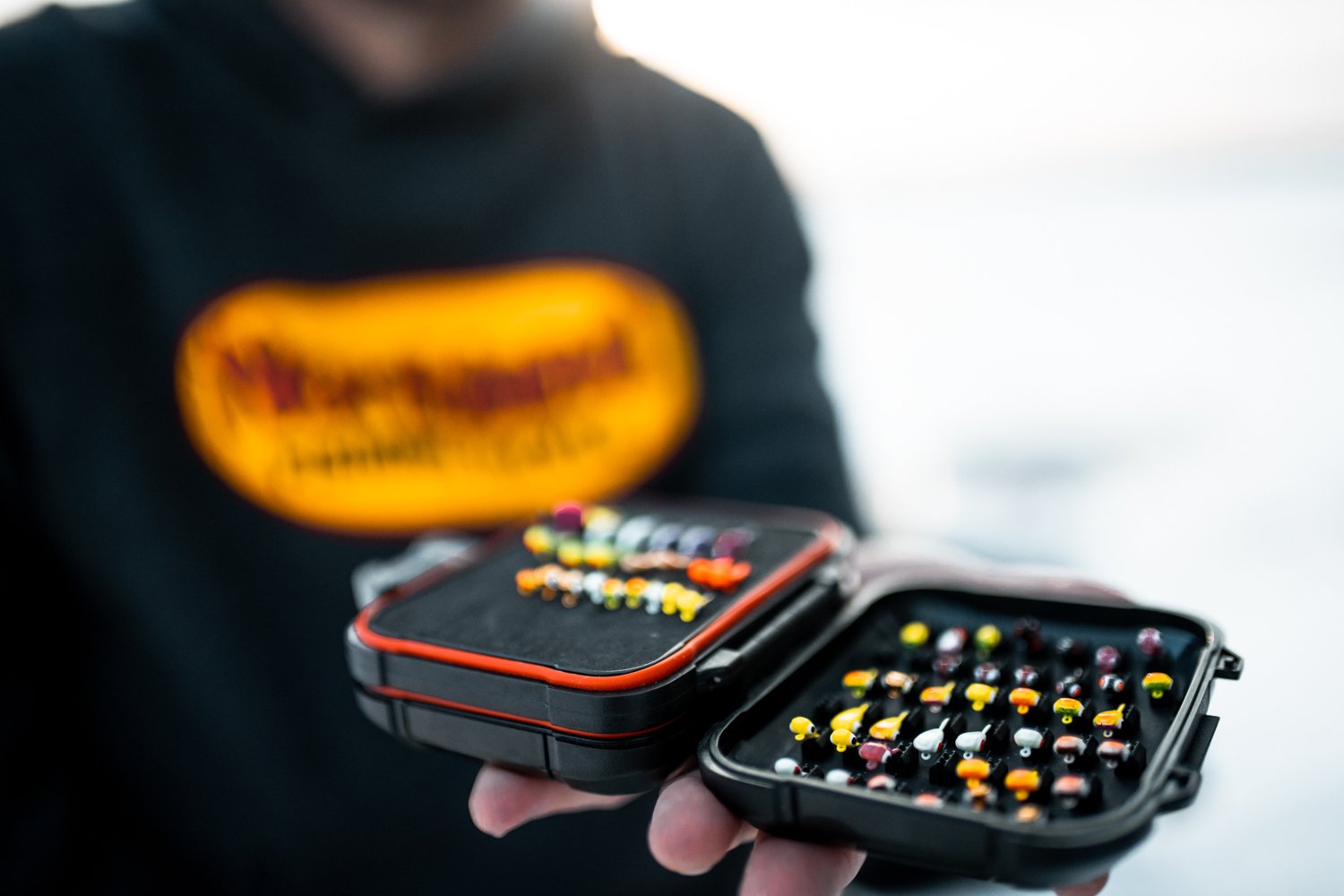Photo - Matt Addington Photography
It’s a popular gripe, on internet forums, facebook groups, and out on the ice too – “That person is way too close!” Surely, if you spend enough time out on the ice, you’ve seen some interesting things. In my time, I’ve had people use my Yetti as a windblock and back-rest, and have even had a complete stranger catch a fish on the tip-up I set. I guess they just couldn’t resist a freshly popped flag (who can), but I was on my way out of the house as they were getting to the line. As I arrived, a plump walleye was flopping on the ice, and the guy looked at me funny, almost as if to inquire if he could keep it without saying a word. I unhooked the fish, released it smiling, and then said that most of the times I have guided in the past, we set the trip up in advance rather than meeting coincidentally on the lake. He got the point.
While some errors in human judgement seem all too obvious, others still are like baseball’s unwritten rules. If you’re part of the club, well-steeped in the history of the game, and follow its lore, well, you know. If you’re new to the crew, then this is stuff you just learn along the way. So it goes out on the open lake where no-size-fits-all, every situation is different, and the answer to the question of “How close is too close” is simple. It’s all relative.
Golden Rule
I’ve seen this one referenced more than enough times to mention myself, that the golden rule itself is a really good litmus test every time you set up. Simply ask yourself the following question – “If I were that person over there, and they came this close to me, would I be too close?” But this rule cuts both ways. That means, you better not raise a stink about someone setting up as close as you do to others, but I see that one broken all the time, even by friends and family. What’s too close for them just doesn’t apply when they’re setting up right on top of others. We’re all fishing a shared resource, but you’d be surprised what can happen on an open lake vs. other shared human experiences. If you wouldn’t budge in line at the DMV, why would you do it on the lake?
Still, that term “relative” keeps popping up. I was fishing some brush piles a few weeks ago that were deliberately set and well known on the lake we were fishing. Here, anglers routinely set wheelhouses, permanents and portables within 30 feet or far closer to existing shelters. I chose to do the same, but only midweek, where the houses I was settling near did not have people fishing in them until the weekend. In this instance, “too close” for me was only too close if I was right on top of another angler actually fishing, but not the wheelhouse or permanent itself.
Contrast that with a big-lake, northern ice belt experience where you’d be the only angler on a key bend of a major piece of mid-lake structure. Let’s say that you’re the only angler on that piece of structure for hundreds of yards and another wheelhouse pulled up inside of 30 feet. In wheelhouse’s or portable-land’s rules, you’d have every right to expect that angler to reposition further away. All of which further underscores the main point here. That answer to what’s too close is invariably – “It depends.”
Don’t Be a Hindrance
One thing that I’ve always tried to do on open water or the ice, was to work with fellow anglers to not get in the way of what they’re trying to do. No one owns a spot, and public waters offer everyone equal rights to enjoy them, but I don’t need to get so close that I affect their fishing. Now, that doesn’t mean I have to stay so far away that I don’t affect their experience. I’ve had anglers chew me out because they wanted a pristine view of the far shoreline, and that’s simply not a reasonable expectation. However, I’m careful to stay far enough away, that noise from my activities on ice, don’t scare fish away or otherwise hurt the bite for them. That includes not showing up on a shallow bite and pounding holes in the ice during primetime, as we continue to learn more about how sensitive fish can be to overhead fishing pressure.
Some states have a legal distance set up to prevent anglers from getting too close to one another. Often those are open water focused, citing a certain distance (like 100 feet) from an anchored vessel. They don’t always transfer well to the ice. That, and I’ve never seen or heard of a conservation officer discuss this with another angler, let alone ticket them. All of which means that while there may be laws on the books, depending on your locale, we all simply have to self-police and figure it out together. What may be too close for you, is no big deal to me, and vice versa, but you shouldn’t hesitate to chat up your fellow angler.
Rules of Thumb
Usually, if you feel you’re too close, you probably are. It’s tempting to see structure just below another house and creep close enough to try and fish the edge, but unless we’re talking about huge chunks of underwater real estate, it’s often best to find another spot. That might mean catching less fish, or even changing your plans, but that’s where that Golden Rule check comes in. If you think you may be likely to hinder another angler’s bite, yet still really would like to fish it, think about striking up a conversation with them. See how amenable they are to having you fish nearby, but also be prepared to read their response and act appropriately.
It's likely that if you fish long enough, you’ll encounter confrontations on ice. Sometimes they’re warranted, often they are not. Most anglers are kind, yet still have their boundaries, just like you probably do. Though, bullies exist in every community, and most of them do it because it has been an effective tactic for them in the past. They wave their arms, try to look bigger than they are, yell, swear, and generally do their best to intimidate. If you’ve been courteous, are outside of any state legal limits for distance, and consider their bite before trying to make your own, know that you have rights too. While I’ve never seen a Conservation Officer respond to a “too close to house” call, I’ve certainly seen people ticketed for angler harassment.
A few years ago I was perch fishing with a good friend and well-known guide on a large, but busy lake in northern Minnesota. We had drilled holes across a large flat, and were hole hopping, catching perch in several of them. Lo and behold, a group of anglers followed our tracks into the area, then started fishing some of the holes we drilled, hopping closer and closer to us as we tried our best to hide the fish we were catching. Eventually, they got right behind us, saw a hookset and flopping fish. As we looked over our shoulders, we saw the deer-hunter-orange clad crew-leader signal to his posse, waving his arms at them to get over closer to us because they saw us catch a fish. We shook our heads, picked up our fish, and vacated the spot we worked all day to find as the perch posse who rolled in late just crowded us until they capitalized on our effort.
Perhaps the best rule of thumb then, is to avoid becoming the guy or gal in a similar story, at some small bar or restaurant somewhere in the ice belt this season.





